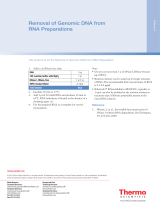
4.1 Procedure
If using the qEV Concentration Kit, separate the EV-bound Nanotrap® particles from the supernatant
by centrifuging the particle-sample suspension at 16,800 x g for 10 minutes at room temperature.
Without disturbing the Nanotrap® EV particle pellet, remove the supernatant (either transfer to a
clean tube for analysis of non-EV components of the sample, or discard). The remaining Nanotrap® EV
particle pellet is now ready for the RNA extraction procedure.
1. To your chosen volume of qEV isolate, add 1.5 volumes of Lysis Buffer A and 0.2 volumes of Lysis
Additive B. This will be your Lysed EV Solution.
E.g., if you have 200 µL of qEV isolate, add 300 µL of Lysis Buffer A and 40 µL of Lysis Additive B,
for a total Lysed EV Solution volume of 540 µL.
n.b., When beginning with an EV pellet such as the Nanotrap® EV particle pellet, add 250 µL of Lysis
Buffer A and 20 µL of Lysis Additive B directly to the EV pellet to produce your Lysed EV Solution.
2. Mix the Lysed EV Solution well by vortexing for 10 seconds, then incubate at room temperature for
20 minutes.
3. Following incubation, add 0.93 volumes (using the volume of the Lysed EV Solution as a reference
volume) of 96%-100% ethanol to Lysed EV Solution and mix well by vortexing for 10 seconds. This is
your Lysed EV Ethanol Solution.
E.g., to 540 µL of Lysed EV solution, add 502.2 µL of ethanol for a final volume of 1042.2 µL.
4. Transfer up to 700 µL of the Lysed EV Ethanol Solution into the mini spin column. Centrifuge for 1
minute at 3,300 x g. Discard flowthrough.
5. Repeat step 4 until all Lysed EV Ethanol Solution has been run through the mini spin column.
6. Apply 600 µL of Wash Solution A to the column and centrifuge for 30 seconds at 3,300 x g, then
discard flowthrough.
7. Repeat step 6.
8. Spin the empty column for 1 minute at 13,000 x g to remove any remaining liquid. Discard collection
tube and transfer the spin column into a fresh 1.7 mL elution tube.
9. Apply a chosen volume of Elution Solution A between 50 and 100 µL to the column and centrifuge
for 1 minute at 400 x g followed by a further 2 minutes at 5,800 x g.
A second elution can be performed if deemed necessary to further maximise recovery. For this, take
the eluate from step 9 (i.e., the same Elution Solution A that has already passed through the column)
and re-apply it to the column. Incubate the column for 2 minutes at room temperature and centrifuge
to re-collect as in step 9. Do not use new Elution Solution A for this optional step if you wish to increase
concentration as this will result in a dilution.
Following extraction, RNA should be stored at -80°C until it is required for downstream applications.
qEV RNA Extraction Kit User Manual 9





















